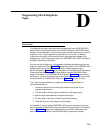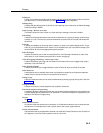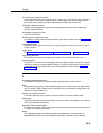
Glossary
GL-3
Call Report
A page of information that begins with a header and lists incoming and outgoing calls to and from
your business on a call-by-call basis.
See also
Call Record
and
Call Reporting.
Call Reporting
A feature that provides records of call activity. Call reporting also is referred to as Station Message
Detail Recording or SMDR.
Call Screening— Release 3.0 or later
This feature allows the user to listen to a caller leaving a message in the user’s mailbox.
Call Waiting
A feature that lets standard phone users receive notification of a second incoming call when they
are busy on a call. The user can press the switchhook to put the first call on hold and answer the
second call.
Caller ID
A feature that displays an incoming caller’s number (or name) on a system display phone. To get
Caller ID, you must subscribe to the service (if it is available) from your local phone company and
connect Caller ID lines to the appropriate system modules.
Caller ID Inspect
A feature that allows you to view incoming Caller ID or Call Coverage information on other lines
while active on a call, without placing the call on hold or hanging up.
Caller ID Logging and Dialing— Release 2.0 or later
A feature that allows you to log and view Caller ID information and to return logged calls using a
dial button.
See also
Caller ID.
Caller ID Name/Number
A feature that allows you to toggle between a caller’s Caller ID name and Caller ID number.
Caller ID Service
A subscription service available from some local telephone companies, providing the telephone
number and/or name of the caller on lines that have the service.
Calling Group
A group of extensions that can be called simultaneously by dialing a group calling code.
See also
Hunt Group.
Calling Restriction
A feature that lets you control telephone use at specific extensions.
Centralized Telephone Programming
A method of telephone programming that lets you program individual extensions in the system from
a system display phone at extension 10 or extension 11. Centralized Telephone Programming is an
alternative to Extension Programming.
CO Line
See
Line.
Combination Extension
An extension that has two devices connected to it. Combination extensions can connect two stan-
dard devices or a standard device and a system phone, but not two system phones.
Contact Closure Button
A phone button that is programmed to activate one of the two Contact Closures on the Contact Clo-
sure Adjunct to control an auxiliary device such as a door lock.


















